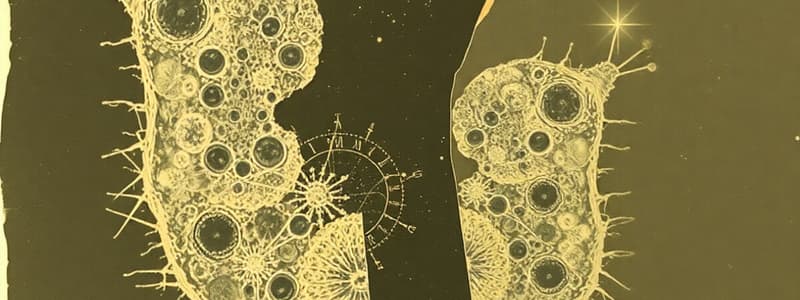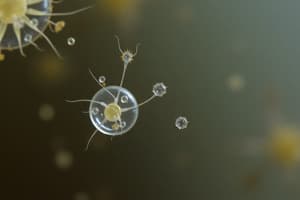Podcast
Questions and Answers
Quali organismos appartiene al grupo Acoelomate?
Quali organismos appartiene al grupo Acoelomate?
- Earthworm
- Flatworm (correct)
- Cnidarian
- Roundworm
Qual es le caracteristica principale de un Pseudocoelomate?
Qual es le caracteristica principale de un Pseudocoelomate?
- Absente de peritoneum (correct)
- Presence de parenchyma solide
- Adoption de un corpo rígido
- Possessor de un vero coelom
Quale organico ha un vero coelom lined with peritoneum?
Quale organico ha un vero coelom lined with peritoneum?
- Flatworm
- Roundworm
- Earthworm (correct)
- Jellyfish
Qual mesoderm structurec es presente in le Acoelomate?
Qual mesoderm structurec es presente in le Acoelomate?
Qual statement es falso ante le organismos coelomate?
Qual statement es falso ante le organismos coelomate?
Qual option describe le sistema corpore interne de un Pseudocoelomate?
Qual option describe le sistema corpore interne de un Pseudocoelomate?
Le qual tipo de corpore plan es caracterisate per 'no coelom'?
Le qual tipo de corpore plan es caracterisate per 'no coelom'?
Quale strato es locate inter le ectoderm e le gut in un Acoelomate?
Quale strato es locate inter le ectoderm e le gut in un Acoelomate?
Qual es le function del flagellum in organismos libere vivente?
Qual es le function del flagellum in organismos libere vivente?
Que describe meliormente le caracteristicas del ectoplasma in locomotion ameboide?
Que describe meliormente le caracteristicas del ectoplasma in locomotion ameboide?
Qual parte del locomotion ameboide es responsabile pro le formation de pseudopodia?
Qual parte del locomotion ameboide es responsabile pro le formation de pseudopodia?
Qual describite meliormente le function del actin microfilaments in locomotion ameboide?
Qual describite meliormente le function del actin microfilaments in locomotion ameboide?
Qual es le principal differenza inter filopodia e reticulopodia?
Qual es le principal differenza inter filopodia e reticulopodia?
Quales organismes s'appartene a le categoria de coelomate?
Quales organismes s'appartene a le categoria de coelomate?
Quale statement describe le pseudo-coelomate correctemente?
Quale statement describe le pseudo-coelomate correctemente?
Quale de illos organismes es classificate como acoelomate?
Quale de illos organismes es classificate como acoelomate?
Quale organisme es typic in le via de incluse in le phylum de Chordates?
Quale organisme es typic in le via de incluse in le phylum de Chordates?
Quale statement es incorrecte circa le bilaterale organismes?
Quale statement es incorrecte circa le bilaterale organismes?
Quale de le sequente organismes non es considerate como metazoan?
Quale de le sequente organismes non es considerate como metazoan?
Quale statement corresponde a le Bryozoans?
Quale statement corresponde a le Bryozoans?
Quale de le sequente pertenece a le categoria de eukaryotes?
Quale de le sequente pertenece a le categoria de eukaryotes?
Quale de le sequente organismes es un exemplo de chordate?
Quale de le sequente organismes es un exemplo de chordate?
Quale statement es ver per le acoelomate?
Quale statement es ver per le acoelomate?
Qual es un exemplo de un gruppo de eucariotes unicellulares con importancia ecologica?
Qual es un exemplo de un gruppo de eucariotes unicellulares con importancia ecologica?
Qual mechanism de locomotion es al letere un 'whip-like outgrowth'?
Qual mechanism de locomotion es al letere un 'whip-like outgrowth'?
Qual de le sequente es caracteristicas del movimento ciliari?
Qual de le sequente es caracteristicas del movimento ciliari?
Qual grupo paraphyletic non include omnes descendentes de un ancestro commun?
Qual grupo paraphyletic non include omnes descendentes de un ancestro commun?
Quot moliedades es identificabile in unicellulares eucariotes?
Quot moliedades es identificabile in unicellulares eucariotes?
Qual organelles non es generalment presente in metazoan cells?
Qual organelles non es generalment presente in metazoan cells?
Quais es le velocitate maximal de ciliates in cm/h?
Quais es le velocitate maximal de ciliates in cm/h?
Quale classe involvere Trypanosoma?
Quale classe involvere Trypanosoma?
Qual es le elemento non associato con le locomotion ciliari?
Qual es le elemento non associato con le locomotion ciliari?
Qual es le significato de 'pseudopodia' in unicellulares eucariotes?
Qual es le significato de 'pseudopodia' in unicellulares eucariotes?
Qual es le function de le 'recovery stroke' in ciliary locomotion?
Qual es le function de le 'recovery stroke' in ciliary locomotion?
Que caracteriza le battimento metachronal de le cilia?
Que caracteriza le battimento metachronal de le cilia?
Qual es le effecto de un barriera o un stimuli nocive in ciliary locomotion?
Qual es le effecto de un barriera o un stimuli nocive in ciliary locomotion?
Qual es le define de un flagellum in flagellar locomotion?
Qual es le define de un flagellum in flagellar locomotion?
Que es le principal function del tractellum?
Que es le principal function del tractellum?
Qual es le function del pulsellum?
Qual es le function del pulsellum?
Qual es le consequence de le battimento ciliar oblique?
Qual es le consequence de le battimento ciliar oblique?
Le direction del aqua durante le pulsallem es?
Le direction del aqua durante le pulsallem es?
Qual es le resultato de le bending contrarietate de le flagellum?
Qual es le resultato de le bending contrarietate de le flagellum?
Cual es le consequence de un flagellum che non se mueve adecuatemente?
Cual es le consequence de un flagellum che non se mueve adecuatemente?
What characterizes acoelomate organisms in terms of body cavity?
What characterizes acoelomate organisms in terms of body cavity?
Which of the following statements about pseudocoelomate organisms is true?
Which of the following statements about pseudocoelomate organisms is true?
What type of body plan do coelomate organisms exhibit?
What type of body plan do coelomate organisms exhibit?
In which of the following types of organisms would parenchyma be expected to occupy the region between ectoderm and the gut?
In which of the following types of organisms would parenchyma be expected to occupy the region between ectoderm and the gut?
Which organism is typically classified as a coelomate?
Which organism is typically classified as a coelomate?
What structure is absent in pseudocoelomates but present in coelomates?
What structure is absent in pseudocoelomates but present in coelomates?
Which of the following best describes the arrangement of organs in a pseudocoelomate?
Which of the following best describes the arrangement of organs in a pseudocoelomate?
What differentiates the internal architecture of acoelomates from that of coelomates?
What differentiates the internal architecture of acoelomates from that of coelomates?
Which type of locomotion involves the use of cytoplasmic streaming and large blunt pseudopodia?
Which type of locomotion involves the use of cytoplasmic streaming and large blunt pseudopodia?
What characterizes the function of actin microfilaments in amoeboid locomotion?
What characterizes the function of actin microfilaments in amoeboid locomotion?
What is the main difference between filopodia and lobopodia in amoeboid movement?
What is the main difference between filopodia and lobopodia in amoeboid movement?
What role does ectoplasm play in amoeboid locomotion?
What role does ectoplasm play in amoeboid locomotion?
Which of the following best describes the nature of reticulopodia?
Which of the following best describes the nature of reticulopodia?
Which characteristic is NOT typically associated with coelomates?
Which characteristic is NOT typically associated with coelomates?
Which of the following animal groups is classified as acoleomate?
Which of the following animal groups is classified as acoleomate?
What type of coelom is typically surrounded by mesodermal tissue?
What type of coelom is typically surrounded by mesodermal tissue?
Which characteristic correctly describes pseudocoelomates?
Which characteristic correctly describes pseudocoelomates?
Which statement about bilaterally symmetrical organisms is accurate?
Which statement about bilaterally symmetrical organisms is accurate?
Which of the following groups is known to be a paraphyletic group?
Which of the following groups is known to be a paraphyletic group?
In the context of ancient metazoans, which feature is NOT indicative of unicellularity?
In the context of ancient metazoans, which feature is NOT indicative of unicellularity?
Which statement correctly characterizes the evolutionary significance of metazoans?
Which statement correctly characterizes the evolutionary significance of metazoans?
Which group is characterized by having a pseudocoelom?
Which group is characterized by having a pseudocoelom?
What is a key feature distinguishing hemichordates from chordates?
What is a key feature distinguishing hemichordates from chordates?
What is the primary purpose of the recovery stroke in ciliary locomotion?
What is the primary purpose of the recovery stroke in ciliary locomotion?
How do cilia facilitate movement through metachronal beating?
How do cilia facilitate movement through metachronal beating?
In ciliary locomotion, how does the organism respond to a harmful stimulus?
In ciliary locomotion, how does the organism respond to a harmful stimulus?
What is the role of the flagellum in flagellar locomotion?
What is the role of the flagellum in flagellar locomotion?
What distinguishes a tractellum from a pulsellum in flagellar locomotion?
What distinguishes a tractellum from a pulsellum in flagellar locomotion?
What is the expected consequence of an oblique ciliary beat?
What is the expected consequence of an oblique ciliary beat?
Which mechanism in flagellar locomotion is responsible for creating a wave action along the flagellum?
Which mechanism in flagellar locomotion is responsible for creating a wave action along the flagellum?
What distinguishes unicellular eukaryotes in terms of feeding and reproduction compared to multicellular organisms?
What distinguishes unicellular eukaryotes in terms of feeding and reproduction compared to multicellular organisms?
Which mechanism is NOT one of the three primary modes of locomotion in unicellular eukaryotes?
Which mechanism is NOT one of the three primary modes of locomotion in unicellular eukaryotes?
How does a flagellum assist sessile flagellates in maintaining movement?
How does a flagellum assist sessile flagellates in maintaining movement?
What occurs when cilia beat in a coordinated metachronal pattern?
What occurs when cilia beat in a coordinated metachronal pattern?
How do ciliates use their cilia to prevent the accumulation of stagnant water around their bodies?
How do ciliates use their cilia to prevent the accumulation of stagnant water around their bodies?
What characterizes the group known as paraphyletic in relation to unicellular eukaryotes?
What characterizes the group known as paraphyletic in relation to unicellular eukaryotes?
Which unicellular eukaryote method allows for feeding through engulfing prey?
Which unicellular eukaryote method allows for feeding through engulfing prey?
What is the key role of unicellular eukaryotes in ecological systems?
What is the key role of unicellular eukaryotes in ecological systems?
Which characteristic is unusual for unicellular eukaryotes compared to metazoans?
Which characteristic is unusual for unicellular eukaryotes compared to metazoans?
Which of the following statements about ciliary beating is accurate?
Which of the following statements about ciliary beating is accurate?
What is the fastest recorded speed of ciliates in centimeters per hour?
What is the fastest recorded speed of ciliates in centimeters per hour?
Which class includes the organism Trypanosoma?
Which class includes the organism Trypanosoma?
Flashcards are hidden until you start studying
Study Notes
Introduction
- Unicellular Eukaryotes, also known as protozoa or protista, are a diverse group of organisms that cannot be easily categorized.
- They are remarkably complex, despite their single-cell structure.
- They are crucial to ecosystems and the economy.
- Unicellular Eukaryotes are a paraphyletic group.
- The classification of Unicellular Eukaryotes:
- Phylum Euglenozoa (includes Euglena and Trypanosoma)
- Amoebas (informal grouping, includes Amoeba)
- Phylum Ciliophora (includes Paramecium)
- Phylum Apicomplexa (includes Plasmodium)
Locomotion
- Unicellular Eukaryotes use three primary methods of locomotion:
- Ciliary motion
- Flagellar motion
- Amoeboid motion
Ciliary Motion
- Cilia are hair-like structures on the cell surface.
- They propel water parallel to the cell surface, enabling directed movement and preventing water stagnation around the organism.
- Cilia beat in a circular motion with two components:
- Power stroke (propels water)
- Recovery stroke (bends towards body, reducing resistance)
- Cilia can beat in a coordinated fashion, known as metachronal beating, to propel the organism.
- Cilia can reverse their beat, allowing for avoidance reactions.
Flagellar Motion
- Flagella are whip-like structures on the cell surface.
- They propel water parallel to the flagellum's main axis, creating a wave-like motion.
- Flagella can be "tractellum" (drawing water towards the cell) or "pulsellum" (propelling the cell).
Amoeboid Motion
- Amoeboid movement utilizes cytoplasmic streaming and large, blunt pseudopodia (lobopodia).
- The cytoplasm has two forms:
- Ectoplasm (gel-like, plasmagel)
- Endoplasm (fluid state, plasmasol)
- Endoplasm fountains out to the periphery, driven by actin microfilaments.
- Other types of pseudopodia include filopodia (slimmer, with only ectoplasm) and reticulopodia (highly branched and complex).
Introduction
- Unicellular eukaryotes are a diverse group, rivaling all other animal groups in complexity.
- They are complex, despite appearing simple, with a single cell capable of feeding, digesting, moving, "behaving" and reproducing.
- They contain organelles not typically found in metazoan cells.
- They are ecologically and economically important, contributing as primary producers and playing roles in decomposition, human and animal health.
Classification
- Unicellular eukaryotes are a paraphyletic group, meaning their most recent common ancestor is also the ancestor of animals, plants, and fungi, so not all descendants are included.
- Important examples include Euglenoids, Trypanosomes, Amoebas, Ciliates, and Apicomplexans.
Locomotion
- Three main methods of locomotion: ciliary, flagellar, and amoeboid.
Ciliary Motion
- Cilia are hair-like outgrowths from the cell's surface.
- Ciliary motion propels water parallel to the surface of attachment.
- Essential for directed movement and preventing stagnant water layers.
- Ciliary beating involves a circular motion with two components: power stroke and recovery stroke.
Flagellar Motion
- Flagella are whip-like outgrowths from the cell's surface.
- Flagellar motion propels water parallel to the flagellum's main axis.
- Bending in opposite directions along the flagellum creates a wave action.
- Tractellum (drawing water towards the cell) and pulsellum (propelling the cell) are different types based on direction relative to cell body.
Amoeboid Motion
- Amoeboid motion uses cytoplasmic streaming and large blunt pseudopodia (lobopodia).
- Ectoplasm (gel-like) and endoplasm (fluid) contribute to the process.
- Actin microfilaments within the cell play a key role in polymerization and structure.
- Thin filopodia and branched reticulopodia are other forms observed.
Studying That Suits You
Use AI to generate personalized quizzes and flashcards to suit your learning preferences.





